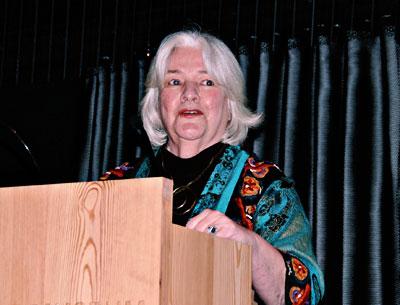LTV’S East End Stories

While every presentation of East End Stories on Film at the Parrish Art Museum in Water Mill offers compelling reasons to see it, last Thursday’s version was particularly rewarding, coming primarily from Genie Henderson and the LTV archive, which dates back to the station’s beginnings in 1984.
Although there are many print documents and archives of the artists who worked and played here over the past century or so, the founding of LTV did as much for the artists as it did for the greater community in preserving a legacy that has only grown more vital and important with the passage of time. Members of the artistic community such as Elaine Benson, Priscilla Bowden, Howard Kanovitz, and Jeffrey Potter hosted shows where artists came on and discussed their lives and work.
Ms. Henderson said the event was the first time the archives had been presented publicly in such a fashion. With 800 shows to choose from, it had to be done on a selective basis and primarily through excerpts.
Connie Fox, who with her husband was one of the first of many artists who saw the value in such an enterprise, was also one of the first to take up a camera and go out and shoot video for the fledgling public access station. One of her early projects was a tour of the 1983 Willem de Kooning retrospective at the Whitney Museum of American Art with Elaine de Kooning. Frazer Dougherty, one of the founders of the station, operated the camera while de Kooning toured the show, “speaking totally extemporaneously about what she remembered. That’s what this video is. Just that, plain and simple.”
De Kooning offered anecdotes about certain paintings, how long they took, who bought them, how her husband titled them, and what influenced them. Stopping at “Rosy Fingered Dawn at Louse Point,” she noted that 1963, when it was painted, “was the year that he really moved completely from New York City to East Hampton,” leading to a marked change in the work and a new appreciation for light and color. The paintings began incorporating “huge areas that just express light and much less of a stress on contours. The city paintings were much more congested, with closeness of forms and compacted areas. These paintings were unleashed. It was almost a gesture of light . . . in these sweeping strokes.”
Included in the presentation was a trailer for the film “Castles in the Sand.” Produced by Max Scott and based on Helen Harrison’s book “Hamptons Bohemia,” it has archival footage and recent interviews with artists such as Jameson Ellis, John Alexander, Keith Sonnier, Donald Sultan, and Jane Martin in which they reflect on the meaning of the area’s historic legacy to those working in the present day.
Ms. Harrison is the narrator of the film and introduced the trailer, which she said would be part of a much longer documentary. The clips showed artists such as Ibram Lassaw and Paul Brach speaking about the beach scene at Georgica and Peter Mattheissen recalling that it was once said, “If you dropped a bomb on a cocktail party in Sagaponack, you’d wipe out three-quarters of the American literary establishment.” Taking up the theme of drinking, Bill King said the whole South Fork artistic community, particularly the Abstract Expressionists, “floated on a sea of alcohol.”
These clips were complemented by more footage from the LTV archives and a screening of a 1972 film by Howard Kanovitz that documents his painting of the picture “Hamptons Drive-In.” The work was recently acquired for the Parrish’s permanent collection and is on view in the new museum. The film follows a painstaking process involving photography, stencils, and airbrushes to create the illusion of what has become known as Photorealism. The old Hamptons Drive-In theater is depicted complete with an image of Joel Grey from “Cabaret” on the screen.
The film is by turns serious and whimsical and embodies a free-spiritedness that seems to mark the best inclinations of the artists who were attracted to this area: all of them very serious people who still knew how to have fun.
